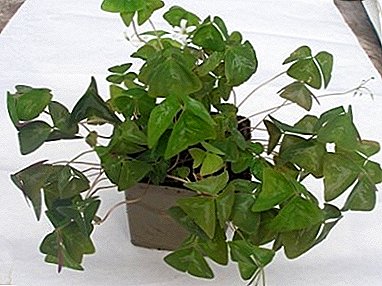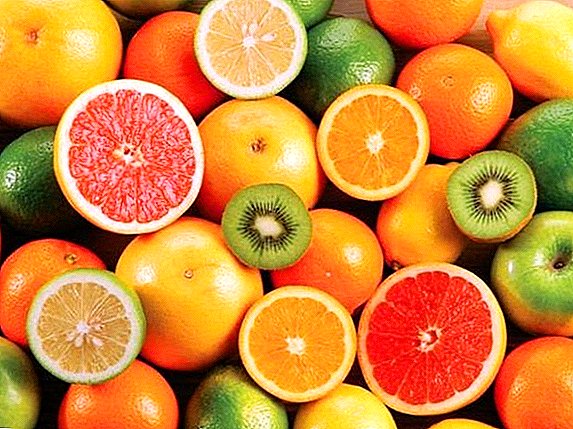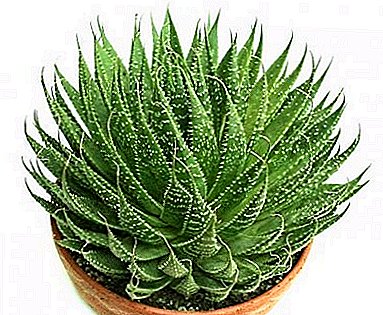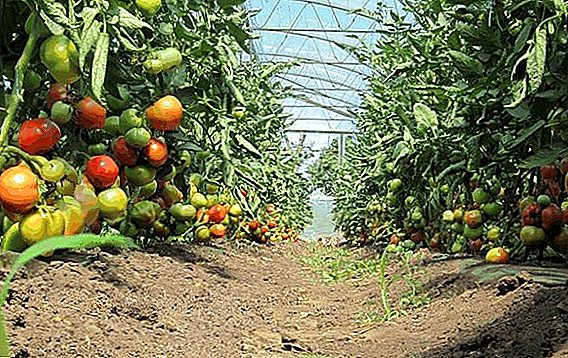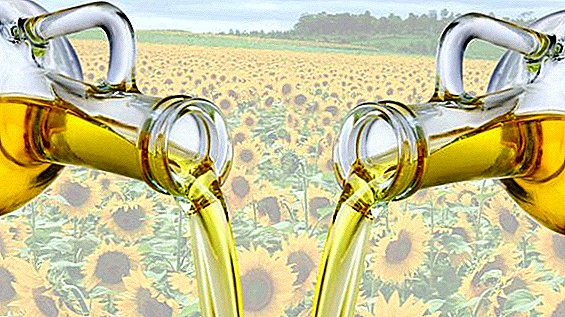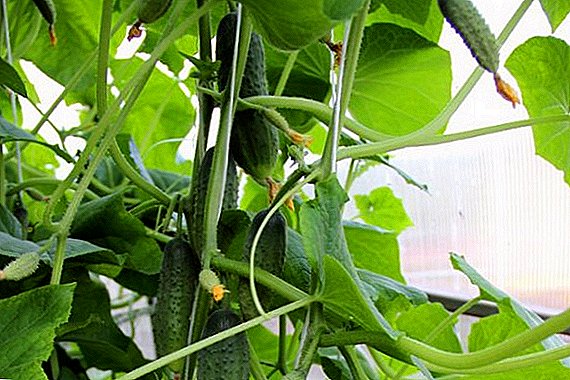 Cucumber varieties differ in a variety of criteria - ripening terms, size, method of pollination, the appointment of fruits, etc. It can sometimes be difficult to determine in all this diversity. But those who own a land plot the size of a small apartment and at the same time like to crunch a cucumber, plucked from their own garden bed or lovingly salted for the winter, should pay attention to the so-called bouquet (or puchkovye) varieties. Their bright representative is the Beam Splendor hybrid.
Cucumber varieties differ in a variety of criteria - ripening terms, size, method of pollination, the appointment of fruits, etc. It can sometimes be difficult to determine in all this diversity. But those who own a land plot the size of a small apartment and at the same time like to crunch a cucumber, plucked from their own garden bed or lovingly salted for the winter, should pay attention to the so-called bouquet (or puchkovye) varieties. Their bright representative is the Beam Splendor hybrid.
Variety description
This hybrid was introduced in 2014 in the Urals, or to be more precise, in Chelyabinsk, it was registered in 2015. The legal owner is Aliluev A.V., a famous agronomist-vegetable grower.
The variety is intended primarily for cultivation in the cold climatic zones of Russia (Siberia, the Urals). Suitable for open ground and for greenhouses or tunnels.
A strong bush of medium branching with small leaves of bright green color forms the ovary of the tuft type, 3-7 pieces in each bunch. All flowers are female and, accordingly, each creates a fruit ovary, ensuring an excellent harvest.  “Beam magnificence” refers to parthenocarpic cucumbers, which some mistakenly call self-pollinating. Classic cucumber varieties suggest the presence of males and females - thus, a gardener needs to plant plants that are not fruitfully known to produce a crop. In addition, in order for the cucumber to start, the participation of a “third person” - a bee is necessary.
“Beam magnificence” refers to parthenocarpic cucumbers, which some mistakenly call self-pollinating. Classic cucumber varieties suggest the presence of males and females - thus, a gardener needs to plant plants that are not fruitfully known to produce a crop. In addition, in order for the cucumber to start, the participation of a “third person” - a bee is necessary.
Check out the most popular varieties of parthenocarpic cucumbers.
Self-pollinated plants have flowers of both sexes and, accordingly, can pollinate themselves, which, of course, is more convenient and beneficial. But parthenocarpic cucumbers are tied without any pollination - all their flowers are female, fruit bearing, and they don’t need a “man” (as well as a bee mediator).
"Puff magnificence" is positioned as a premium class cucumber, who took all the best from the parent varieties.
So, among the advantages of the hybrid note:
- cold resistance;
- resistance to sharp temperature fluctuations, including between day and night temperatures;
- resistance to high humidity, including heavy fogs, which most cucumber varieties tolerate very poorly;
- no need for pollinating insects;
- high yield with a small area;
- very long period of fruiting;
- high taste of fruits;
- universality of fruits in the directions of their use;
- resistance to such common fungal infections as powdery mildew, peronosporosis and brown spotting, as well as to the cucumber mosaic virus.
Important! Distinctive feature of parthenocarpic Cucumber is that they have no seeds.
 The disadvantages of the "Bundle magnificence" include:
The disadvantages of the "Bundle magnificence" include:
- the very high cost of seeds and the impossibility of their independent harvesting (the latter applies to any hybrids, but is compensated for by their excellent qualities compared to high-quality vegetables);
- high demands on soil fertility and feedings;
- instability to drought (regular watering and loosening of the soil is required);
- intolerance to weeds (weeding is required);
- the need for proper formation of the bush for high-quality harvest.
Fruit characteristics and yield
“Puff magnificence” is gherkins (this term is known to be called small-fruited cucumber varieties). The length of the fruit is from 8 to 11 cm mass - 60-80 g. The cucumbers have a regular cylindrical shape with a narrowed tip, small tubercles with white spikes and dense edges. Color gherkins light green with a darker shade at the base and short light stripes from the tips to the center.
Yield hybrid strikes the imagination.
Important! Varieties of cucumbers, providing a yield of 25 kg per square meter, are considered high-yielding. The productivity of "Beam Splendor" - 40 kg per square!
With proper care from each bush can remove up to four hundred gherkins. Such amazing results are achieved due to the fact that cucumbers ripen very quickly, and the fruiting period lasts up to five months, depending on climatic conditions: the first fruits ripen within six weeks after sowing, and this magnificence ends (in all senses of the word) only with the arrival of the first frost.  Not failed and taste of the fruit. There is almost no bitterness in them; cucumbers are dense and crunchy, but at the same time very tender, even slightly sweet, and fragrant. Equally well suited for fresh consumption, and for salting or pickling, and in the blanks fully preserved the original crispness of the gherkins.
Not failed and taste of the fruit. There is almost no bitterness in them; cucumbers are dense and crunchy, but at the same time very tender, even slightly sweet, and fragrant. Equally well suited for fresh consumption, and for salting or pickling, and in the blanks fully preserved the original crispness of the gherkins.
Selection of seedlings
Cucumbers sprout perfectly right in the open field, and therefore, if there is no desire or opportunity to mess with seedlings, it is better to plant a seed immediately than to acquire a germinated plant.
Did you know? Cucumbers are not only the lowest-calorie of all vegetables (not surprising, considering that the fruit is 98% water), but they can rightly be called natural antidepressants and analgesics. In addition, these amazing fruits help to get rid of the painful coughing attacks (if you drink the juice with honey), and when used as a mask - significantly improve the condition of the skin of the face and neck.
Purchased seedlings have one very significant drawback: it is almost impossible to accurately determine the type of plant by its appearance. With regard to hybrids, this problem is of particular relevance - since they can be grown only from purchased seeds, which, moreover, are quite expensive (for example, just five seeds of “Beam Splendor” will cost about 90 rubles), the probability of falling into the trap fraudsters and purchase instead of the declared elite variety, having a mass of advantages, something completely different, is very high.
VIDEO: HOW TO CHOOSE THE BEST CROWN
But if such considerations do not scare, Choose seedlings that have:
- no more than three or four true leaves;
- bright green color without any trace of yellowing;
- fresh and healthy appearance: no damage, dried fragments and traces of diseases or pests are allowed (especially to inspect the inner side of the leaflets);
- individual container (cup): seedlings with an open root system take root poorly.
Soil and fertilizer
Best of all, the bundle hybrid will feel on a sandy or loamy soil with a neutral reaction (pH level is within 6-7). You can achieve good results on clayey soil, but in this case you need to put sand into the ground at the rate of 20 liters per square meter.
Important! The more acidic the soil (lower pH level), the less suitable it is for growing cucumbers.
The best predecessors for the hybrid are solanaceae (tomatoes, potatoes, eggplants, peppers), as well as carrots and cabbage.  You can not plant a "bundle magnificence" after:
You can not plant a "bundle magnificence" after:
- any types of cucumbers, including such exotic varieties as Antilles, snakes, Mexicans, red, etc .;
- squash;
- squash;
- watermelons;
- melons;
- any type of pumpkin.
- if the acidity is too low (the pH level is above 7.4), the bed should be poured with an acidic solution (one and a half to two tablespoons of oxalic or citric acid, or 100 g of table or apple vinegar in a bucket of water);
- To reduce the acidity (if the pH is below 6), the soil is enriched with liquid alkaline organic fertilizers or dolomite flour, chalk, wood ash or slaked lime are added.
Learn how to determine the acidity of the soil at home.
 After snow melting, the bed is dug up to the depth of the spade bayonet, after which you need to make a tab of organic fertilizers, best of all compost. The prepared area is plentifully watered with water and covered with a film that will allow the ground to warm up well.
After snow melting, the bed is dug up to the depth of the spade bayonet, after which you need to make a tab of organic fertilizers, best of all compost. The prepared area is plentifully watered with water and covered with a film that will allow the ground to warm up well.
Growing conditions
In order for the “Beam Splendor” to delight us with the promised yield indicators, in addition to the fertile soil, it is necessary to ensure:
- a lot of heat;
- a lot of light;
- a lot of moisture.
Did you know? It is not known for certain which breeder belongs to the palm of superiority in the cultivation of bouquet cucumbers. However, there is a version that specimens with such a form of the ovary were found back in 1787 among cucumbers of the variety "Vyaznikovsky", and the attention was first paid to them by the famous Russian writer, philosopher and "part-time" botanist Andrei Timofeevich Bolotov.
Heat is the main condition for success. Despite the fact that the hybrid is initially focused on growing in cold regions, it still remains a thermophilic plant. At temperatures below 12 ° C you can not count on a friendly abundant fruiting. Ideal performance - from 25 to 30 ° C during the day and from 15 to 18 ° C at night.
A sufficient amount of light is also an important indicator, although not so important. Cucumbers prefer that their green sides are open to the rays of the summer sun.
High humidity of cucumbers is necessary both in the soil (not less than 80%) and in the air (75-90%), and this requirement must be observed throughout the growing season.
Growing from seed to seedlings at home
 Cucumbers are among those crops that are not necessarily grown from seedlings. Some experts strongly recommend planting seeds immediately in open ground, as the crop grows very quickly, but the transplant is difficult enough. But there is an opposite position: properly prepared seedlings allow you to get a harvest a couple of weeks earlier than the neighbors. To which camp to join, every summer resident can decide for himself, but if the choice is made in favor of the second point of view, the most important thing is not to hurry with the landing.
Cucumbers are among those crops that are not necessarily grown from seedlings. Some experts strongly recommend planting seeds immediately in open ground, as the crop grows very quickly, but the transplant is difficult enough. But there is an opposite position: properly prepared seedlings allow you to get a harvest a couple of weeks earlier than the neighbors. To which camp to join, every summer resident can decide for himself, but if the choice is made in favor of the second point of view, the most important thing is not to hurry with the landing.
Particular attention should be paid to the choice of capacity for seedlings. Learn about the advantages and disadvantages of growing seedlings in peat tablets, cassettes, diapers.
If tomato seedlings are recommended to be sown for about 60 days before the proposed planting in open ground, and eggplants and peppers are formed even longer, then cucumbers can be planted a maximum of three weeks, and if you have a lot of sun on the window and the temperature is quite high - even later. Overgrown cucumbers have been ill for a long time after transplantation, and the plant is literally drawn out before our eyes!
Seed preparation
Conventional seed preparation for planting involves a decontamination procedure and, preferably, stimulation and quenching. However, "Beam Splendor" does not need such events.
Important! The first generation hybrids (they can be identified by the presence on the envelope of the designation "F1" after the name of the variety) do not need to be processed before planting, since all necessary manipulations with seed material have already been carried out by the manufacturer. Thus, any additional effects on the seeds of one or another drug may be detrimental to the plant.
Hybrid varieties are generally recommended to be sown dry; however, for cucumbers, pre-soaking for faster germination does not hurt.  The seeds are laid out between two layers of soft, damp cloth (you can take gauze folded in several layers, but sprouted seeds often take roots from the yarn and, removing them, we risk damaging the root). An improvised envelope is placed in a plastic bag and placed in a warm place, preferably on a battery. If it is very hot, put a terry towel or other thick cloth on it, and place a bag of seeds on top.
The seeds are laid out between two layers of soft, damp cloth (you can take gauze folded in several layers, but sprouted seeds often take roots from the yarn and, removing them, we risk damaging the root). An improvised envelope is placed in a plastic bag and placed in a warm place, preferably on a battery. If it is very hot, put a terry towel or other thick cloth on it, and place a bag of seeds on top.
After 2-3 days, carefully open the envelope and check: suitable for planting the seeds should "hatch" (give a tiny root). Tightening with the landing is not necessary, otherwise the root will stretch and twist, then it will be too easy to break.
Content and location
Cucumber seedlings do not need to swoop down (opinions on this matter diverge, but the plant objectively develops so quickly, and transplants it is so hard that the extra manipulation does not make sense), so regular tapes for seedlings are not suitable in this case. Prepare separate cups for each bush (ideal - peat, this will reduce stress from the subsequent landing in open ground to a minimum).  The soil mixture for future seedlings can be purchased at a specialty store, and you can prepare it yourself by mixing in the ratio 4: 1: 1 humus, peat and sawdust. It is necessary to add complex mineral fertilizer (you can also use nitrophoska) and dolomite flour or wood ash (1 tablespoon per 10 kg of soil) to the obtained substrate.
The soil mixture for future seedlings can be purchased at a specialty store, and you can prepare it yourself by mixing in the ratio 4: 1: 1 humus, peat and sawdust. It is necessary to add complex mineral fertilizer (you can also use nitrophoska) and dolomite flour or wood ash (1 tablespoon per 10 kg of soil) to the obtained substrate.
Seed planting process
Prepared cups are filled with soil mixture to the top. Then a special nutritional mixture is prepared: 2 tbsp. mullein spoon, 1/3 tbsp. spoons of copper sulphate, 1 tbsp. spoon of urea and 10 liters of water. All components dismount, the liquid is heated to 40 ° C, after which it should be very rich to moisten the soil in the pots, so that the earth subsided. Then a new portion of earth is filled into the tank, and the procedure is repeated.  A seed is laid out in the soil prepared in this way, then a layer of dry earth 2 cm thick is poured on top.
A seed is laid out in the soil prepared in this way, then a layer of dry earth 2 cm thick is poured on top.
Important! Only one germinated seed should be placed in each cup, since it is impossible to divide the cucumbers before planting, this will damage the root system. And to remove a weaker plant, as gardeners sometimes do, as applied to a very expensive hybrid, would be wrong.
 After laying, the pot can be covered with cling film to create a greenhouse effect and put into a shaded place until the first sprouts appear (for germinated seeds this will happen very quickly, in just a couple of days). After that, the film is removed, and the pots are taken out for growing on a well-lit window sill.
After laying, the pot can be covered with cling film to create a greenhouse effect and put into a shaded place until the first sprouts appear (for germinated seeds this will happen very quickly, in just a couple of days). After that, the film is removed, and the pots are taken out for growing on a well-lit window sill. 
Seedling care
If the seedlings of the “Beech Splendor” are intended for cultivation in protected places (under film or glass), adherence to a strict temperature regime does not matter much: a normal room temperature will be quite enough. But for growing in open ground, the plant needs to be hardened.
The optimum temperature indicator for the period until the first true leaflets appear - 25 ° C. When this happens, you can put the pots in a cooler place with the obligatory presence of a difference between day and night temperatures. It is good if in the afternoon seedlings will be in the range of 20-22 ° C, and at night 15-18 ° C. Best for these purposes is suitable unheated balcony overlooking the sunny side. If the seedlings are on the window sill inside the apartment, you should not open the window for the night to provide coolness, as cold through air can adversely affect the seedlings.  Water cucumbers need to plentiful, pre-standing up the water and heating it to 30 ° C. It is better to do this in the morning, so that excess moisture does not stagnate in cold soil, and in any case not allow liquid to get on the leaves (watering is carried out strictly at the root).
Water cucumbers need to plentiful, pre-standing up the water and heating it to 30 ° C. It is better to do this in the morning, so that excess moisture does not stagnate in cold soil, and in any case not allow liquid to get on the leaves (watering is carried out strictly at the root).
A few days before planting, a more serious hardening of the seedlings should be carried out with the pots placed outside - at first briefly, and then more, gradually bringing the seedlings to stay on the street to full days.
Transplanting seedlings to ground
The formation time of cucumber seedlings ranges from two to three weeks, depending on the amount of light and temperature. But it is very important to correctly determine the time of planting young plants in the open ground, since unexpected night frosts are not able to endure even the cold-resistant “Beam Splendor”.
Important! There is a national sign that allows you to determine the optimal time for planting cucumbers in open ground. This moment coincides with the period of the beginning of flowering of lilac and yellow acacia.
The plant needs a sufficiently high temperature not only of air, but also of the soil - it must warm up to at least 10 ° C to the depth of the roots, that is, at least 10 cm. This condition can be met by covering the prepared bed with a film in advance.
A couple of days before planting seedlings need to stop watering. Thus, then it will be possible to carefully remove the bush from the cup together with the earthy clod, without disturbing the root system. For seedlings grown in peat cups or tablets, this rule does not apply.
"Beam Splendor" is planted according to a scheme that assumes a minimum distance between plants of 50 cm.  Planting is done as follows: a 10 cm deep hole is dug out in a prepared bed, 1 liter of a weak solution of potassium permanganate is poured into it for disinfection, then an earthen room with a bush is carefully installed, the earth is poured from all sides, and the hole is carefully tamped.
Planting is done as follows: a 10 cm deep hole is dug out in a prepared bed, 1 liter of a weak solution of potassium permanganate is poured into it for disinfection, then an earthen room with a bush is carefully installed, the earth is poured from all sides, and the hole is carefully tamped.
Did you know? At this time in the world there are more than eight hundred varieties and hybrids of cucumber.
Agrotechnics growing seeds in open ground
The first time after transplantation, young cucumbers need protection from possible night frosts. Therefore, it is very desirable to build a small miniature room for them. To do this, small arcs are made of any bending material and are dug into the ground with two ends, after which the structure is covered with a film, and its edges are pressed to the ground with any weight (for example, stones or bricks).
When the plant is fully accepted, and the weather finally gets better, the care of the “Puchkov splendor” will be reduced only to watering, feeding, loosening and weeding, as well as to timely harvesting.
Outdoor conditions
The "bundle magnificence" with the same success can be grown in greenhouses and in the open field. This hybrid is good because it grows well without shelter even in fairly cold conditions. Therefore, the choice of the method of cultivation depends solely on the personal preferences of the gardener and, in fact, the presence of the greenhouse.
Check out the features of growing cucumbers in the greenhouse.
 In it, cucumbers will be less dependent on temperature fluctuations; in a greenhouse, it is easier to create constantly high air humidity, and, moreover, the fruiting period will last a little longer. But, on the other hand, the greenhouse option involves its own difficulties - the need for airing, additional costs for the construction of a greenhouse, etc.
In it, cucumbers will be less dependent on temperature fluctuations; in a greenhouse, it is easier to create constantly high air humidity, and, moreover, the fruiting period will last a little longer. But, on the other hand, the greenhouse option involves its own difficulties - the need for airing, additional costs for the construction of a greenhouse, etc.
Learn how to make a greenhouse in the country with their own hands, and how to make their own arc for the greenhouse.
The site for planting is selected based on the preferences of the crop - maximum sun and heat and, if possible, protection from the wind, which can damage long lashes with heavy brushes.
The process of planting seeds in the ground
Planting cucumber seeds can be carried out directly in open ground, without prior cultivation of seedlings. In this case, the seeds are immediately laid on a permanent place according to the above scheme (50x50 cm), so as not to injure the plants with a transplant.
Important! The opinion that greenhouse cucumbers have lower palatability is erroneous. In fact, the most delicious gherkins can be grown under film and on the ground. Similarly, in either case, a negative result is possible. It all depends on compliance with technology.
Despite the fact that the seeds of the “Beech Splendor” are expensive, it makes no sense to expect a miracle and plant seeds that have not sprouted in the process of soaking into the ground: such savings will only lead to the fact that fewer plants form on the harvested bed and, consequently, everything will result in losses in general yield level.
VIDEO: LANDING CUCUMBERS WITH SEEDS IN OPEN GROUND The rest of the planting technology differs little from growing seedlings: the ground is well watered with a nutrient solution (at the same time you can add a disinfectant component in the form of potassium permanganate), then germinated seeds are laid out on the surface, dry ground is covered and the bed is covered with a film until germs appear. It is even better to immediately organize a greenhouse, as for planted seedlings, so as not to do double work.
When the weather is completely established, and the plants form 4-5 true leaves, the film can be removed.
Watering
The “bundle magnificence”, like other representatives of the species, is very picky about constant watering, but the amount of moisture necessary for the proper development of the plant is not the same throughout the different stages of its growth.
Important! Cucumbers need to be watered frequently and plentifully during a period of active growth and the formation of green mass. After the appearance of the first buds, the regularity of watering is slightly reduced, but when gherkins begin to form, it increases again, and after that remains stably frequent.
No matter how moisture-loving a hybrid is, it endures stagnation of water in the root system very poorly. Therefore, during the rainy season watering should be completely stopped.  Drip irrigation If it is better to water cucumber seedlings in the morning, then the plants planted on the beds - on the contrary, towards evening. Water at the same time must correspond to the air temperature. Water the bushes need only under the root.
Drip irrigation If it is better to water cucumber seedlings in the morning, then the plants planted on the beds - on the contrary, towards evening. Water at the same time must correspond to the air temperature. Water the bushes need only under the root.
You can build drip watering from ordinary plastic bottles.
Soil loosening and weeding
To loosen the soil is necessary after each watering to prevent its drying out. A very important element in the cultivation of the Beam Splendor is also the regular removal of weeds - they take advantage of the useful elements from the soil, and in addition, they are carriers of various infections, including those to which the Ural hybrid does not have increased resistance.
Masking
Another condition necessary for obtaining a high yield of the “Bundling Magnificence” is the proper formation of a bush.
This hybrid is characterized by self-regulation of branching according to the second type: due to the huge number of gherkins ripening on the main stem, the side shoots are not able to grow intensively. But it is still necessary to ensure that the plant retains only one stem, - due to this, the full ripening of the fruits on all the numerous hands is ensured.  The first pasynkovanie held at the level of the third and fourth leaflet. After that you should remove all the shoots that the plant will throw on the sides. Thus, only leaflets and “bouquets” with flowers and ovaries should be on the main stem, no side branches.
The first pasynkovanie held at the level of the third and fourth leaflet. After that you should remove all the shoots that the plant will throw on the sides. Thus, only leaflets and “bouquets” with flowers and ovaries should be on the main stem, no side branches.
Garter
There is a way to grow cucumbers without a garter, when the plant is allowed to freely move along the ground. But for bundle varieties, this option is not very suitable, and in general has a lot of flaws.
In particular, The garter provides:
- growing the maximum number of plants on the minimum area (the stem starts up and does not take up much space in the garden);
- maximum and uniform illumination of each gherkin in the hand (if the whip is lying on the ground, this will not be possible);
- more convenient formation of the stem (to remove side shoots on a vertically growing stem is easier, so they are better visible);
- high-grade processing of a plant (it is more difficult to spray the lying stalk);
- easy and pleasant harvesting process (all fruits are at arm's length, no need to bend over);
- lack of interference that creeping plants create to each other;
- lack of contact with the earth, and, therefore, reduction of risk of infection with fungal infections.
Important! The high-yielding “Bundling splendor” with an abundance of fruit-bearing brushes on the stalk is simply necessary.
There are several varieties of garter:
- horizontal (two supports on the sides of the bed and the threads stretched between them);
- vertical (each bush is provided with an individual "pole" - twine or other support, along which the plant moves up);
- net (similar to vertical, but instead of a separate guide bushes provided with plastic mesh for support).



Top dressing
The enormous productivity of the "Beam Splendor" requires constant fertilizing. By the way, this feature applies to absolutely all types of bouquet cucumbers.
In addition to fertilizing the soil before planting, the plant needs to repeat this procedure every two weeks after the formation of the first gherkins. Initial fertilizer need to spend nitrogen fertilizer, it will accelerate the formation of new fruit brushes.
In the future, fertilizing should be carried out by alternating organic and mineral fertilizers. Among the first, the advantage is to give compost. Manure and bird droppings are a little less successful option - they can oversupply the soil with nitrogen, which adversely affect the yield and quality of fruits, as well as burn the delicate root system of the cucumber.
From mineral fertilizers, you can use such mixtures as "Master", "Crystal", "Mortar" and other complex additives.
VIDEO: SUPPORTING CUCUMBERS DURING FLOWERING
Pests, diseases and prevention
Although the creator of the “Beam Splendor” declares the hybrid's resistance to some “professional” diseases of cucumbers, the plant can still suffer from fungal infections, in particular, white and root rot. The first affects the fruits, making them soft and disgustingly slippery, the second - the plant itself. In both cases, the cause is high humidity. In addition, these diseases can provoke a sharp temperature drop or violation of the landing pattern.
In the case of white rot, it is usually recommended to cut off the affected area, but in relation to the “Beam Splendor” forming in one stem, you will have to get rid of the whole bush. The same fate awaits plants affected by root rot. Therefore, it is better to prevent the development of infection, observing the mode of ventilation (for the greenhouse) and avoiding waterlogging. As a preventive measure, you can also treat the plant with copper sulphate and urea (respectively, 2 and 1 teaspoon per bucket of water).
Important! The causative agents of white and root rot persist in the soil, so even after removing plants from it, the problem cannot be considered resolved until complete disinfection of the soil is carried out with a strong fungicide or dry bleach.Of the pests of cucumbers, the greenhouse whitefly is the most dangerous.
 Greenhouse whitefly Its larvae can be found on the back of the leaves. The pest not only sucks the juice from the green organs, but is also a peddler of another fungal infection, the soot fungus.
Greenhouse whitefly Its larvae can be found on the back of the leaves. The pest not only sucks the juice from the green organs, but is also a peddler of another fungal infection, the soot fungus.For prophylaxis and treatment, spraying with Verticillin at a rate of 250 g of the drug per bucket of water or Inta-vir (three tablets per one volume) is used three times with a week break.
Harvesting and storage
Another specific feature of the “Beam Splendor” is that in order to get maximum yield, the growing cucumbers should be immediately removed. Growing over, they not only lose their attractiveness, but also retard the growth of smaller “brethren,” so that those who decide to try growing this hybrid in their area need to prepare for daily harvesting.
Cucumbers are perishable. In the refrigerator, they usually lie no more than five days, in the heat they start to rot even faster.
Longer remain fresh fruit:
- absolutely dry (collected in dry weather, not washed);
- intact;
- not overgrown.
Find out how salted cucumbers are useful and how to cook them at home.

Did you know? Cucumber, whose homeland is India, China, Japan and the western part of Asia, is now distributed almost throughout the world. So, only in Russia the area of its cultivation covers 90 thousand hectares. Champions in the cultivation of this culture are also China, India, Japan, USA, UK, Germany and Ukraine.
Possible problems and recommendations
Hybrid "Beam Splendor" has a lot of advantages, but unpretentiousness definitely does not apply to them. Growing a high-yielding gherkin can be accompanied by a variety of problems. Perhaps the answer to the question, what is the cause of the trouble and how to help the plant, you will find in the table below.
| Description of the problem | Possible reasons | Recommendations |
| The cucumber is drawn out, the leaves have a pale color, the flowering is later and not abundant, the number of ovaries in the bundle is less than the set, the low taste of the fruit | Lack of light | Provide better coverage, or adjust for landing next year. |
| Cucumbers gorchat, poorly developed, the plant is sick, the leaves turn yellow | Water entering the leaves during watering | Water the plant at the root |
| Ovaries are not formed, and those that have appeared fall down, not ripening; leaves turn yellow and dry | Not enough nutritious soil | Adjust feed mode |
| Rotting stalk | Stagnant water in the soil | Limit watering |
| The leaves turn yellow and dry | Moisture deficit | Increase watering |
| Hypothermia | Cover cucumbers with film | |
| Root system damage | Try treating the soil with insecticide |
Bouquet cucumbers are a remarkable achievement of selection, because they provide an opportunity to get abundant yields in very small areas. "The bundle magnificence", in addition to incredible productivity, has a lot of additional advantages, including excellent frost resistance, which is not very characteristic of this heat-loving vegetable culture. This hybrid is quite demanding and does not forgive possible flaws in the "appeal", but if you manage to adapt to the difficult nature of the Ural gherkin, the reward for love and care will be a steady harvest of excellent cucumbers throughout the summer and even autumn!





